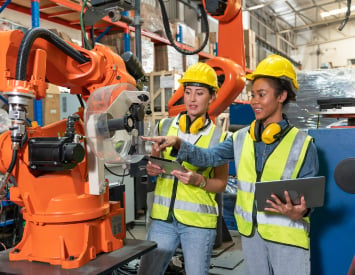Oil hydraulics and pneumatics are two branches of engineering dealing with fluid power to perform work. These systems are integral to various industrial and mechanical applications, providing a means to transmit power in a controlled and efficient manner.
The portable hydraulics trainer used by the Engineering Institute of Technology (EIT) is used to teach the Mechanical Engineering students about ‘Oil Hydraulics Systems’ including actuators, prime mover, pumps, filters, and various control devices.
Students learn about basic components, circuit building and troubleshooting of the hydraulic system. This hydraulic trainer is small, lightweight, and easy to move, which works as an ideal trainer in classroom or laboratory environments.
Dr. Milind Siddhpura is one of EIT’s Mechanical Engineering Lecturers and Course Coordinators who facilitates many courses in mechanical engineering. He provides a clear understanding of oil hydraulics and pneumatics in engineering.
What are Oil Hydraulics Systems?
Oil hydraulics involves the use of pressurized liquids, typically oil, to transmit power. The basic components of a hydraulic system include pumps, cylinders, valves, and motors. The power in a hydraulic system is transmitted through the oil, which is pressurized by the pump and directed through valves to create linear or rotary motion.
Applications of Oil Hydraulics
Hydraulic systems are known for their ability to exert large forces and are commonly used in heavy machinery such as excavators, loaders, and presses. They are also used in precision equipment like aircraft controls and robotic arms.

What are Pneumatics Systems?
Pneumatics, on the other hand, employs compressed air to do the work. Pneumatic systems consist of compressors, actuators, valves, and fittings. The air is compressed by the compressor, routed through valves, and then used to move actuators or cylinders.
Applications of Pneumatics
Pneumatic systems are typically used in applications where quick, repetitive motions are required. They are found in factory automation, pneumatic tools, and heating, ventilation, and air conditioning (HVAC) control systems.
Advantages and Disadvantages
Both systems have their merits and demerits. Hydraulics can generate more power and is suitable for applications requiring precise control and large force. Pneumatics is cleaner, simpler, and safer, making it ideal for food production and clean room environments.
Watch Dr. Siddhpura’s demonstartion here:
The Future of Fluid Power
With advancements in technology, the applications of oil hydraulics and pneumatics are expanding. Engineers continue to develop systems that are more efficient, reliable, and environmentally friendly, ensuring that fluid power remains a vital component of modern engineering.
EIT Courses
EIT has a range of courses in Mechanical Engineering from professional certificates, diplomas, advanced diplomas, graduate certficates, graduate diplomas, bachelor’s degrees, master’s degrees, and doctorate degrees.
Enrol today.


